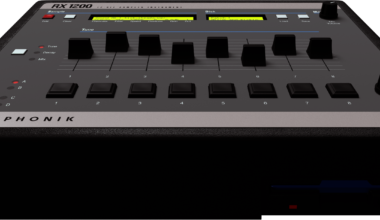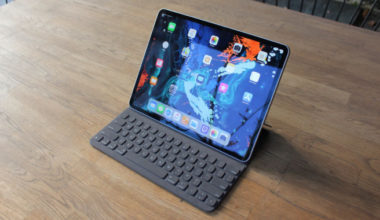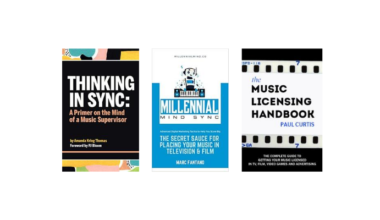
Imagine this: You’re sitting on your couch, engrossed in the latest episode of your favorite TV show. Suddenly, a song starts playing in the background. It’s perfect. It captures the mood of the scene so well, it’s as if the song was written just for this moment. You think to yourself, “Wow, my music could do that!” Well, my friend, you’re absolutely right. Your music could be the perfect fit for a scene in a TV show or a movie. But how do you get it there? That’s where sync licensing comes in. And learning the secret of how to pitch your music for sync licensing placements could take your career to new horizons.
Sync licensing is like the secret sauce that adds that extra zing to a scene. It’s the magic that happens when the right song meets the right visual moment. But getting your music into that magic circle requires more than just a sprinkle of fairy dust. It requires understanding the process, crafting the perfect pitch, and knowing how to navigate the world of music supervisors and sync licensing companies.
So, if you’re ready to take your music from your studio to the silver screen, you’re in the right place. In this blog post, we’re going to delve into the nitty-gritty of “How to pitch your music for sync licensing placements”. So, grab your notebook, put on your learning cap, and let’s dive in!
The Pitching Process: Your Roadmap to Sync Licensing Success
So, you’re ready to pitch your music for sync licensing placements. That’s fantastic! But where do you start? Well, the pitching process is a bit like planning a road trip. You need to know your destination, plan your route, and make sure your vehicle is in top shape. Let’s break it down.
Step 1: Identify Your Destination – Finding the Perfect Sync Home for Your Music
The first step in your sync licensing journey is identifying your destination. This is where you want your music to end up. It’s like choosing the perfect vacation spot. You don’t just pick a place at random, right? You think about what you enjoy, what kind of experience you’re looking for, and what places would offer that. The same goes for choosing the right shows or movies for your music.
Start by thinking about the genre and mood of your music. Is it upbeat and energetic? Then maybe it’s a good fit for a lively, fast-paced comedy. Is it moody and introspective? Then perhaps it would work well in a deep, thought-provoking drama.
Next, immerse yourself in these shows. Watch them, understand their vibe, their style, their rhythm. Pay close attention to the kind of music they use, not just the genre, but also the mood, the lyrics, the instrumentation. This will give you a better understanding of what kind of music they’re looking for.
Remember, this is not just about getting your music on any show or movie. It’s about finding the right fit for your music. It’s about finding a place where your music can shine, where it can add value, where it can enhance the storytelling.
So, take your time with this step. Do your homework. And most importantly, trust your instincts. Because when it comes to music, there’s no better guide than your own intuition.
Step 2: Plan Your Route – Navigating the Sync Licensing Landscape
Now that you’ve identified your destination, it’s time to plan your route. This is where the real work begins. It’s like planning a road trip. You can’t just hop in your car and start driving, right? You need to know where you’re going, the best route to get there, and what stops you need to make along the way. In the world of sync licensing, this means doing your research and finding the right people to connect with.
Start by looking up the shows or movies you’re interested in on IMDb. This is like your road trip map. It gives you all the information you need about the show, including the all-important name of the music supervisor. The music supervisor is like your final destination. They’re the person who decides what music gets used in the show or movie.
Once you have the name of the music supervisor, it’s time to find their contact information. This can be a bit tricky, as music supervisors are often inundated with pitches and may not have their contact information readily available. But don’t let that deter you. A bit of online sleuthing, networking, and maybe even a bit of good old-fashioned snail mail can get your music into the right hands.
Remember, planning your route is not just about finding the quickest way to your destination. It’s about understanding the landscape, knowing the challenges you might face, and being prepared to overcome them. So, do your research, be persistent, and keep your eyes on the prize. Because when it comes to sync licensing, the journey is just as important as the destination.
Step 3: Get Your Vehicle in Top Shape – Preparing Your Music for the Journey
Now that you’ve identified your destination and planned your route, it’s time to get your vehicle in top shape. In the world of sync licensing, your vehicle is your music and how you present it. Just like you wouldn’t set off on a road trip in a car that’s falling apart, you shouldn’t pitch your music without making sure it’s in the best possible shape.
First things first, you need to have high-quality WAV files of your music. This is like having a car that’s in good working order. It’s the basic requirement for your journey. Music supervisors won’t even consider your music if it’s not in the right format or if the quality is poor.
Next, you need to have your lyrics and contact information readily available. This is like having your driver’s license and registration. If a music supervisor is interested in your music, they need to be able to reach you quickly and easily.
Finally, you need to have all your metadata squared away. Metadata is all the details about who owns the rights to the music, who the writers are, and who to contact for clearance. It’s like having your road trip itinerary, with all the details of where you’re going, where you’re staying, and what you’re doing. Without it, you could run into all sorts of problems along the way.
Remember, preparing your music for the journey is not just about ticking off a checklist. It’s about making sure your music is presented in the best possible light. It’s about giving your music the best chance of being chosen for a sync licensing placement. So, take the time to get your vehicle in top shape. Because when it comes to sync licensing, you want to make sure your music is ready for the ride of its life.
The Perfect Email: Your Golden Ticket to Sync Licensing Success
So, you’ve identified your destination, planned your route, and got your vehicle in top shape. Now, it’s time to hit the road. But before you do, you need to craft the perfect email. This is like your golden ticket, your passport to sync licensing success. But what makes an email perfect? Let’s break it down.
Subject Line: Your Billboard on the Information Highway
Think of your subject line as a billboard on the information highway. It’s the first thing a music supervisor sees when they open their inbox, and it’s your chance to make a strong first impression. But with hundreds of emails vying for their attention, how do you make yours stand out? Let’s dive in.
Relevance is Key
The first rule of crafting a compelling subject line is relevance. You need to show the music supervisor that your email is worth their time. One way to do this is by referencing an artist or song that has been placed in the show recently. This shows that you’ve done your homework and that you understand the kind of music they’re looking for. It’s like saying, “Hey, I see you, I understand you, and I have something you might like.”
Keep it Short and Sweet
The second rule is to keep it short and sweet. Music supervisors are busy people, and they don’t have time to read long, convoluted subject lines. So, get straight to the point. Mention the artist or song you’re referencing, and hint at the similarity with your music. It’s like a teaser trailer for a movie. It needs to give just enough information to pique their interest and make them want to know more.
Make it Personal
Finally, make it personal. Show the music supervisor that you’re not just another musician looking for a placement. Show them that you’re a fan of their work, that you appreciate their taste in music, and that you believe your music would be a good fit for their show. It’s like a personalized invitation. It shows respect, appreciation, and a genuine interest in working with them.
Remember, your subject line is your billboard on the information highway. It’s your chance to grab the music supervisor’s attention and make a strong first impression. So, take the time to craft a compelling subject line. Because in the world of sync licensing, a good first impression can make all the difference.
Body: Your Pitch – The Heart of Your Email
After crafting an attention-grabbing subject line, it’s time to focus on the body of your email. This is where you make your pitch. It’s like the heart of your email, pumping life into your proposal and giving the music supervisor a reason to listen to your music. But how do you craft a pitch that resonates? Let’s find out.
Start with a Compliment
Everyone likes to be appreciated, right? So, start your email with a compliment. Show the music supervisor that you respect their work and appreciate their taste in music. It’s like a warm handshake or a friendly smile. It sets a positive tone and creates a connection right off the bat.
Reference Your Subject Line
Next, reference the artist or song that you mentioned in your subject line. Explain how your music is similar and why you think it would be a good fit for the show. This is your chance to show the music supervisor that you’ve done your homework and that you understand what they’re looking for. It’s like presenting a well-thought-out argument. It shows that you’re serious about your proposal and that you’ve put effort into understanding their needs.
Showcase Your Music
Finally, showcase your music. But don’t just say, “Here’s my music, hope you like it.” Be specific. Highlight the tracks that best fit the show and explain why. Talk about the mood, the lyrics, the instrumentation. Show the music supervisor that you understand your music and how it can add value to their show. It’s like presenting a curated selection of your best work. It shows that you respect their time and that you’re confident in your music.
Remember, the body of your email is your chance to make your pitch and convince the music supervisor to listen to your music. So, take the time to craft a compelling pitch. Because in the world of sync licensing, a well-crafted pitch can be the difference between a pass and a placement.
Attachments: Your Music – The Star of the Show
Now, let’s talk about the star of the show – your music. In the world of sync licensing, your music is like your audition tape. It’s what the music supervisor will use to decide whether your music is a good fit for their show. But how do you present your music in the best possible light? Let’s find out.
Link, Don’t Attach
First things first, don’t attach your music to the email. Attachments can be cumbersome, they can make the email slow to load, and they can even trigger spam filters. Instead, provide a link to a streamable selection of your music. This could be a SoundCloud playlist, a Bandcamp page, or a private page on your website. It’s like giving the music supervisor a VIP pass to a private concert. They can listen to your music at their own pace, in their own time, and in the comfort of their own space.
Curate Your Selection
Don’t just link to your entire discography and expect the music supervisor to sift through it. Be selective. Choose the tracks that best fit the show and that best showcase your talent. This shows the music supervisor that you respect their time and that you understand what they’re looking for. It’s like a curated art exhibition. Each piece is carefully chosen for its relevance, its quality, and its ability to resonate with the audience.
Label Your Tracks Properly
Finally, make sure your tracks are properly labeled. Include the title, the artist, and any other relevant information. This makes it easy for the music supervisor to identify the tracks and to find them again if they want to listen to them later. It’s like the caption under a painting. It gives the viewer the information they need to fully appreciate the work.
Remember, your music is the star of the show. It’s what the music supervisor is really interested in. So, take the time to present it in the best possible light. Because in the world of sync licensing, your music is your ticket to success. Feel free to access our free music supervisor pitch generator to help jump start you in crafting the perfect pitch.
Sync Licensing Companies: Your Trusted Travel Companions
In the journey of sync licensing, you don’t have to travel alone. There are companies out there that specialize in sync licensing and can help you navigate the landscape. These companies are like your trusted travel companions. They know the terrain, they have the connections, and they can help you reach your destination. But what exactly do these companies do, and how can they help you? Let’s find out.
What Are Sync Licensing Companies?
Sync licensing companies, also known as music libraries or publishers, are companies that specialize in placing music in TV shows, movies, commercials, and other media. They have relationships with music supervisors and production companies, and they have a catalog of music that they can pitch for placements. It’s like having a travel agent who knows all the best spots and can get you the best deals.
How Can They Help You?
Sync licensing companies can help you in several ways. First, they can pitch your music for placements. This can save you a lot of time and effort, as they have the connections and the expertise to get your music in front of the right people. It’s like having a tour guide who can take you straight to the best attractions.
Second, they can handle the business side of things. They can negotiate the licensing fees, handle the paperwork, and make sure you get paid. It’s like having a travel companion who takes care of all the logistics so you can focus on enjoying the journey.
Finally, they can provide feedback and guidance. They can help you understand what kind of music is in demand, what you can do to improve your chances of getting a placement, and how you can grow as a musician. It’s like having a travel buddy who’s been there, done that, and can share their wisdom and experience with you.
Remember, sync licensing is a journey, and it’s always better when you have good company. So, consider partnering with a sync licensing company. They can be your trusted travel companions, helping you navigate the landscape, reach your destination, and enjoy the journey. Access our complete directory of the top sync licensing companies.
Conclusion: The Final Note in Your Sync Licensing Symphony
So, there you have it. The ins and outs of how to pitch your music for sync licensing placements. It’s like we’ve composed a symphony together, each section building on the last, culminating in a beautiful crescendo of knowledge and understanding.
We’ve explored the importance of identifying your destination and planning your route, ensuring your music is in top shape for the journey, crafting the perfect email pitch, and even considering the assistance of sync licensing companies. Each step is a crucial note in the melody of your sync licensing success.
But remember, like any good symphony, it’s not just about the individual notes. It’s about how they all come together to create something beautiful. It’s about the journey, the process, the learning, and the growth. It’s about putting your heart and soul into your music and sharing it with the world.
So, take what you’ve learned here today, apply it, and start your sync licensing journey. It may seem daunting at first, but remember, every great journey begins with a single step. And who knows? Your music might just be the next big hit on a popular TV show or movie.
So, go forth, pitch your music, and let the world hear your symphony. Because in the world of sync licensing, your music is the star of the show. And who knows? Your next email could be the one that lands you that dream placement. So, here’s to your success, and remember, the world is waiting to hear your music.
And if you haven’t already, feel free to check out my book, “The Secret Sauce For Placing Your Music in Television & Film.”





